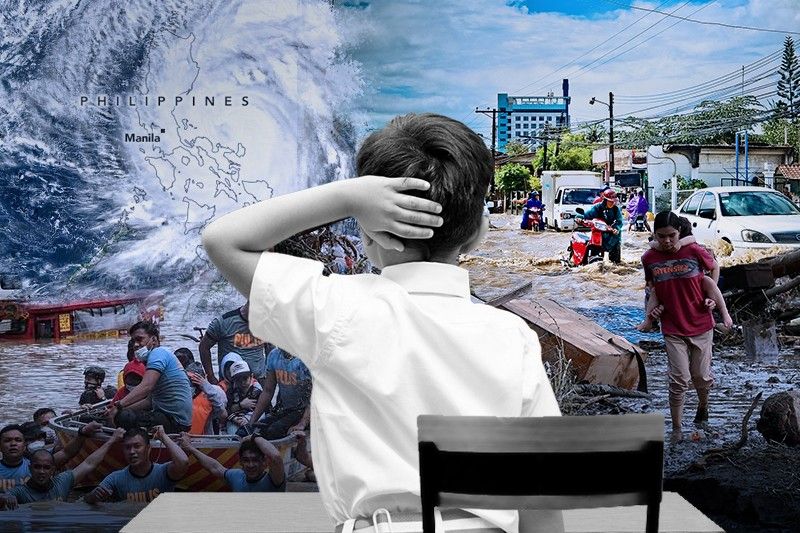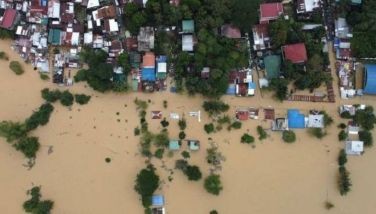Climate change is a societal issue. Why is teaching it limited to memorizing science?

First of a two-part special report on climate change education. Read the second story here.
MANILA, Philippines — Anita Napoto was only six years old when Super Typhoon Yolanda (Haiyan) — one of the strongest tropical cyclones ever recorded — pummeled her hometown of Quinapondan in Eastern Samar in 2013.
At the time, Napoto had no idea what caused the monster storm that flattened her neighborhood. All she remembered was the fear she felt while staying inside her home’s comfort room as the floodwater rose and moving to a relative’s house where she and her family waited for the storm to pass.
Now 15, Napoto knows that climate change is fueling cyclones to become stronger. For survivors like her, Yolanda made it clear that climate change is a reality.
And yet Napoto herself says she does not recall being taught what fossil fuels and local climate change policies are. Climate change “was not actually taught, but was only mentioned” in school, said the Grade 10 student.
Filipino children like Napoto continue to be disproportionately at risk of experiencing climate disasters. But climate change still does not feature as prominently in most class discussions in public schools, with lessons on climate change confined to being taught in just a single quarter — or two to three months — in Grade 9, DepEd’s Science curriculum shows.
During this limited time, the topic of the factors that cause climate change are lumped together with the topic of the global climate phenomenon.
While DepEd requires climate change to be taught in an “integrated and multidisciplinary” approach, students and teachers interviewed by Philstar.com say that there is little opportunity for science and social science teachers to collaborate on teaching climate change.
RELATED: UNICEF: Filipino children among most at risk from 'overlapping' climate hazards | Climate disasters affect kids from 5.6 million poor Filipino families — group
Unsatisfied with lessons on climate change, Napoto said there must be in-depth discussions on the causes of the crisis.
“In that way, students will be more knowledgeable about this issue and can make actions to end this,” she told Philstar.com.
Climate change education still stuck to basics
Three students from Fortune High School in Marikina City similarly told Philstar.com that they are “not satisfied” with their lessons on climate change, with 15-year-old Elijah Chua remarking: “We want to know deeper. Not just the factors that affect the climate.”
Chua and his two classmates said that they were taught that "stopping fossil fuels" is one of the ways to curb the climate crisis. But they were not taught which countries needed to stop the use of dirty energy.
"The countries that need to stop using fossil fuels were not mentioned in class. No specific country — but all countries," Chua said. Glossing over details like which countries produce the most emissions risks missing discussions on responsibility, and on loss and damage, and climate reparations.
How much time is typically devoted to teaching climate change? For instance, junior high schools in CALABARZON only tackle fundamentals of climate change for two weeks in Grade 9 science classes, according to its publicly available learning modules. In comparison, lessons on volcanoes are taught for four weeks.
The DepEd earlier said that “there is a need to strengthen [the presence of climate change concepts] in the curriculum by refining learning competencies and standards and monitoring learning delivery.”
In senior high school, a special subject called Disaster Readiness and Risk Reduction is offered as part of the Science, Technology, Engineering, and Mathematics strand. Climate change competencies can also be found in subjects such as earth science, and life science.
Teaching climate change across subjects
According to the K to 12 curriculum, climate change concepts are supposed to be integrated in 12 subjects: Science, Health, Araling Panlipunan, Edukasyon sa Pagpapakatao, Mathematics, English, Filipino, Edukasyong Pantahanan at Pangkabuhayan & Technology and Livelihood Economics, and Music, Arts, and PE.
However, Leonora Calicdan, a Grade 9 science teacher from Mangaldan High School in Pangasinan, said she is mostly unaware of how climate change is taught in the social sciences.
“I just do not know what competencies are in social science. But I know they are discussing this,” said Calidan, who has taught science for 25 years.
Mark Bello, Fortune High School’s Grade 9 science teacher, said that teachers from different subject areas usually have different schedules and have no time to “sit down” and plan an interdisciplinary class output on climate change.
Leah Cortez, a professor at the Philippine Normal University who teaches science teachers in graduate school, said that an interdisciplinary approach is essential in teaching a topic as complex and multidimensional as climate change.
“We really have to understand community, environment, politics—those are not separate from climate change… We have to integrate this knowledge in various disciplines so they can develop a more holistic understanding,” Cortez said.
Chuckie Calsado, who teaches biology subjects at the Philippine Science High School, incorporates social issues in class discussions so students can better understand the political and economic influences that impact climate change.
“So if we do not include social issues in science discussions, we will be creating scientists and scholars—kabayo na may takip sa mata na nakatingin lang sa harap. You cannot see that around you there are issues that impact you,” he said.
Another problem: Bello also said that his students typically struggle with the application of climate change concepts learned in class, especially in their “daily life.”
Counterproductive school programs
DepEd established its sole student-led environment organization YES-O in 2003 and now touts it as one of the ways students can apply what they have learned about climate change in class. The organization’s activities include tree planting, clean-up drives, waste management, and environmental information and education.
“We make it fun. We make it happy. We do it to pass the time. We show students that we’re not just all about clean-ups,” said 15-year-old Jeremy Agullana, vice president of Fortune High School’s YES-O club.
The problem is not all YES-O clubs are managed by science teachers with a comprehensive knowledge about climate change, Cortez said.
“Based on my students’ reports, they encourage their students to join these clubs. But once they’re (members), they don’t use or encourage students when it comes to actual climate change and environmental concerns,” the PNU professor added.
Calicdan said that the YES-O club in Mangaldan National High School focuses on waste segregation and planting activities, as well as joining interschool and interclass competitions related to these.
But well-intentioned programs on bottle recycling and class competitions based on reusing materials can be counterproductive and inadvertently encourage students to produce more waste, Cortez pointed out.
These projects are “superficial” and not sustainable in the long run, the PNU professor said.
“I scold my students (who are public school teachers) in grad school. When they tell me that they ask their students to bring bottles for recycling, I tell them: you’re encouraging students to use more bottles because you incentivize them to bring as much as they can,” Cortez said in Filipino.
“In one instance, one teacher said they asked their students to create a gown using recyclable materials. Their students used newly bought plastic spoons and forks. What’s the logic of that?” Cortez said.
With just slightly off-the-mark messaging, recycling programs can lead to the unintended consequence of getting students to compete against each other in terms of who can bring — therefore, create — the most trash, Cortez said.
‘Systemic, not individual issue’
Napoto said she is worried about how climate change will chart the course of the world and impact her future.
The Yolanda survivor said this is why she “follows advice on doing good things like using eco-bags, paper bags, not cutting trees.”
Calsado said that the challenge is still on how to shift the focus away from individual solutions to curbing waste to a more systemic approach.
“The challenge is: how do you make children understand and process by themselves, that it’s not an individual issue. It’s a systemic issue, it’s a class issue,” Calsado added.
- Latest

























